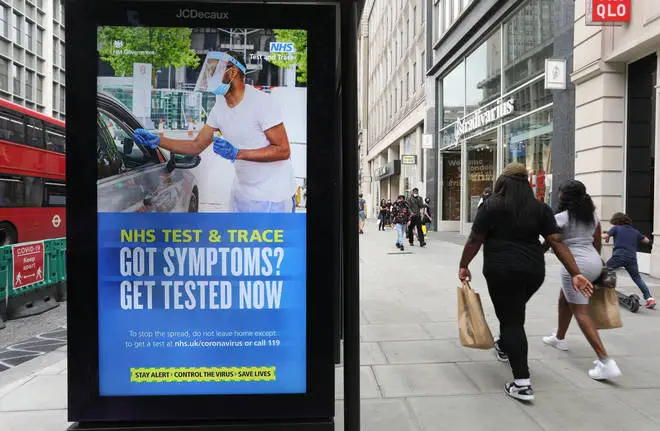
Simon Marks 3pm - 7pm
10 August 2020, 18:04

The NHS Test and Trace system is cutting 6,000 staff in England by the end of August as local authorities are given their own teams of contact tracers.
Following criticism that the national system was not tapping into local knowledge, councils will be given their own teams, who may visit people at home if they cannot be contacted over the phone.
The Department for Health and Social Care said as the contact tracing system becomes "more locally targeted", NHS Test and Trace will "will reduce current extra capacity and reduce the number of non-NHS call handlers".
Read more: The last thing we want to do is to close schools: Boris Johnson
Read more: Covid-19 contact tracers report taking just a handful of calls per month
The national service will move from 18,000 to 12,000 contact tracers on August 24, with remaining teams to be deployed as part of dedicated local tracers.
The approach has already been successfully used in Blackburn with Darwen, Luton and Leicester and is now being offered to all upper tier Local Authorities who are responsible for public health locally.

Covid-19 contact tracer "has made just two calls since May"
Blackburn deployed its own officers after cases there spiked to the highest in the country, with local director of public health and wellbeing saying the national system was "simply not tracing enough cases and contacts fast enough."
There has been criticism that some contact tracers have contacted just a handful of people.
But DHSC said that staff numbers can "quickly scaled up, or down depending on requirements for the national service".
Baroness Dido Harding executive chair of NHS Test and Trace said: "NHS Test and Trace is one of the largest contact tracing and testing systems anywhere in the world, and was built rapidly, drawing on the UK's existing health protection networks, to stop the spread of coronavirus.
"At the height of the pandemic we ensured the system had extra capacity in place to cope with potential peaks in the virus.
"We have always been clear that NHS Test and Trace must be local by default and that we do not operate alone - we work with and through partners across the country.

The UK will have a test & trace operation with 25,000 trackers
"As we learn more about the spread of the disease, we are able to move to our planned next step and become even more effective in tackling the virus.
"After successful trials in a small number of local areas, I am very pleased to announce that we are now offering this integrated localised approach to all local authorities to ensure we can reach more people in their communities and stop the spread of Covid-19."
James Jamieson, chairman of the Local Government Association, added: "This announcement is good news for everyone.
"A strong national and local partnership is critical for test and trace to work as effectively as possible and it is right that local resources are kept under constant review to ensure everyone involved is able to help stop the virus spreading further.
"Using councils' unrivalled local knowledge and vast experience of contact tracing within local public health teams is vital in the Government's national efforts."
All the data from national and local teams will be fed into the same system, DHSC said.
Listen & subscribe: Global Player | Apple Podcasts | Google Podcasts | Spotify
Meanwhile, Public Health England's local health protection teams have doubled in size and will increase further ahead of winter, DHSC added.
It said that there are 200 mobile testing units already in operation and over 200 walk in centres will be opened across the country by October.
Commenting on the announcement, Keith Neal, emeritus professor in the epidemiology of infectious diseases at the University of Nottingham, said: "The biggest issue has been that 20-25% of cases have not been contactable. Allowing local authorities to chase up will ensure more are contacted.
"Visiting houses will help but there is no mention as to what they will do if they are not isolating for 10 days as they should be.
"The advantage of a national system is that it can divert resources to hotspots. In some places there are very few cases, others have many more, so there is likely to be a capacity issue in some areas.
"A centralised system can divert resources where they are needed more efficiently. Whoever makes contact needs to keep the local PHE team informed of the results.
"The key step is that local Public Health England teams oversee this as local authorities are too small and in some places three or four authorities are within a few miles of each other.
"The local authorities cannot continually be checking with each other about cross-border issues which is where the local PHE teams are needed to co-ordinate."